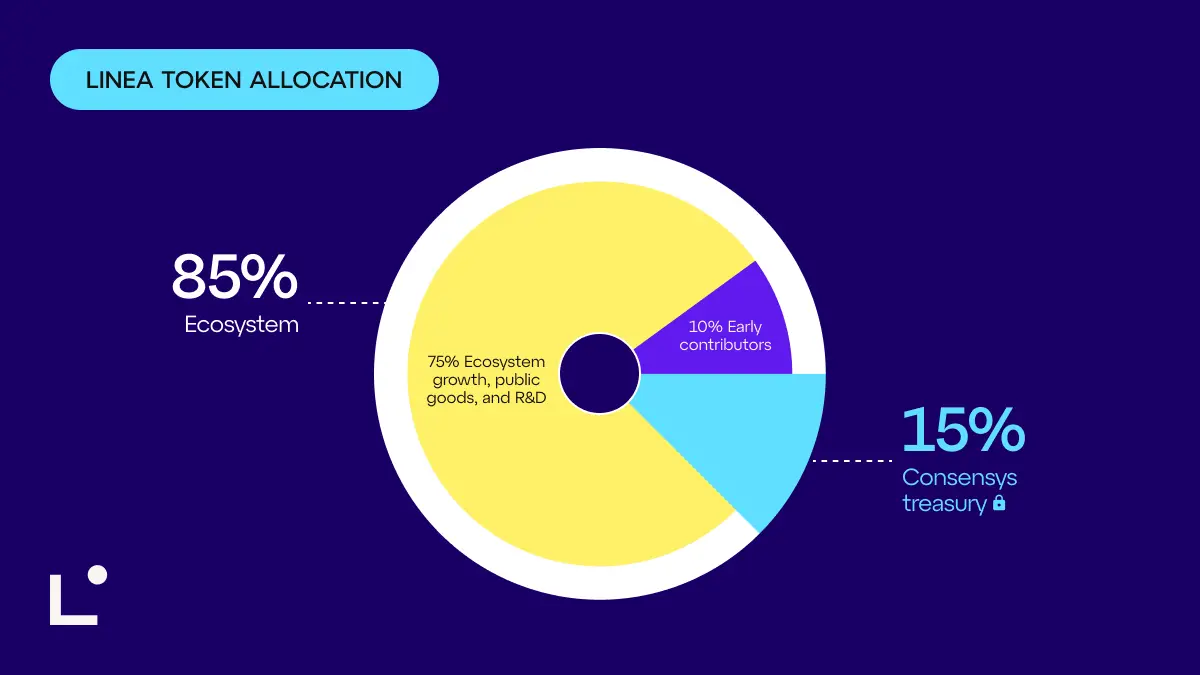Linea’s LINEA token features a total supply of 72 billion tokens, with 9% allocated for an airdrop to early users, marking a significant launch in Ethereum Layer 2 solutions.
-
Linea revealed its tokenomics for the LINEA token, with a 72 billion total supply and 9% allocated for an airdrop to early users.
-
Key details such as the Token Generation Event timeline, airdrop eligibility, and supply control remain unconfirmed.
-
Backed by Consensys, Linea’s high token supply raises concerns about inflation and potential selling pressure after launch.
Linea announces LINEA tokenomics with 72 billion supply and 9% airdrop. Discover key details and implications for Ethereum Layer 2 users today.
What Are the Key Features of LINEA Tokenomics?
Linea’s LINEA tokenomics reveal a total supply of approximately 72 billion tokens, a figure 1,000 times larger than Ethereum’s initial circulating supply. This high supply is unusual for a Layer 2 token and includes a 9% allocation reserved for an airdrop to early users. However, critical details such as the Token Generation Event (TGE) timeline and eligibility criteria for the airdrop have not been disclosed.
How Will the LINEA Airdrop Be Distributed?
The airdrop represents a significant portion of the total supply, aimed at rewarding early adopters. While the exact distribution methods and timelines remain unclear, Linea plans to implement various token distribution strategies, including an ETH-based yield mechanism and an ecosystem development fund. These initiatives indicate a strategic approach to network growth and user engagement.

LINEA tokenomics. Source: Linea
Why Does the Large Token Supply Raise Concerns?
The massive 72 billion token supply has sparked debate within the crypto community. Such a high supply can lead to inflation risks and potential value dilution if not managed properly. Without clear token lockup mechanisms or distribution controls, the market may face selling pressure following the TGE. This concern is heightened given Linea’s recent blockchain halt, which has raised questions about its decentralization commitment.
What Are the Implications for Ethereum Layer 2 Users?
As a project backed by Consensys, Linea holds significant credibility within the Ethereum ecosystem. Early users and developers are closely watching the token launch for its impact on Layer 2 adoption. The transparency in releasing tokenomics is a positive step, but the community awaits further clarity on operational details to fully assess the token’s long-term value and utility.
| Tokenomics Aspect | Value | Comparison |
|---|---|---|
| Total Supply | 72 Billion LINEA | 1,000x Initial ETH Supply |
| Airdrop Allocation | 9% | Significant Early User Incentive |
| TGE Timeline | Unconfirmed | Pending Official Announcement |
Frequently Asked Questions
What is the total supply of the LINEA token?
The LINEA token has a total supply of approximately 72 billion tokens, which is notably higher than many other Layer 2 tokens.
How will the LINEA airdrop work for early users?
Linea plans to allocate 9% of its total token supply for an airdrop to early users, but specific eligibility and distribution details are yet to be announced.
Is the large token supply a risk for investors?
A high token supply can increase inflation risk and potential selling pressure if not managed with proper lockups and distribution strategies.
Key Takeaways
- Massive Supply: LINEA token’s 72 billion supply is unusually high for a Layer 2 token.
- Airdrop Incentive: 9% of tokens are reserved for early users, encouraging network adoption.
- Unclear Details: Token Generation Event and distribution specifics remain unconfirmed, creating uncertainty.
Conclusion
Linea’s announcement of its tokenomics, featuring a 72 billion supply and a substantial airdrop allocation, marks a pivotal moment for Ethereum Layer 2 solutions. While backed by the reputable Consensys, the large supply raises valid concerns about inflation and market dynamics. Continued transparency and detailed disclosures will be essential for building trust and ensuring long-term success within the Web3 community.






